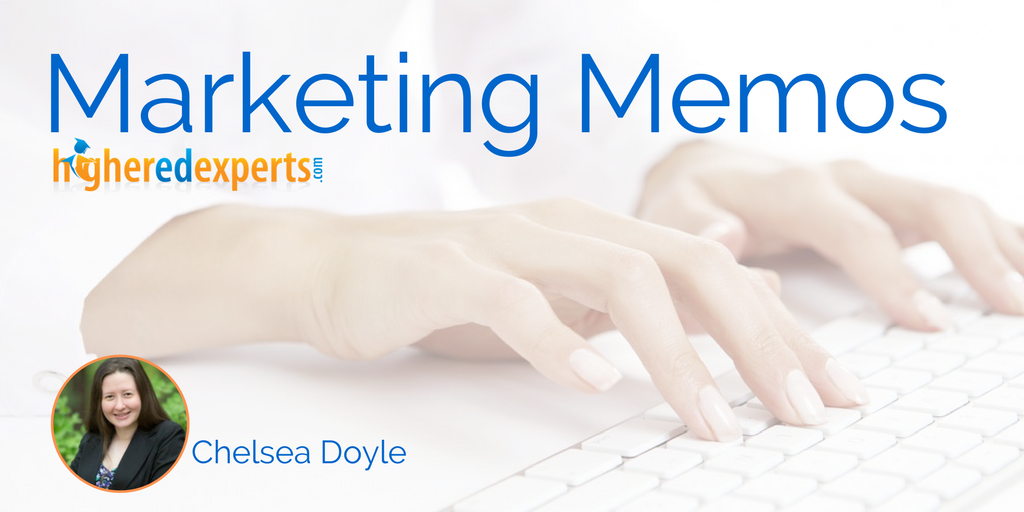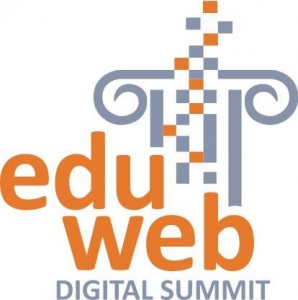
The 2018 edition of the EduWeb Conference took place in July in sunny San Diego this year.
It was an incredible experience full of networking with like-minded people willing to share ideas and brainstorm, and relevant panels about higher education web, digital, social media, and metrics. I compiled a top ten list of what I learned both in the sessions I attended as well as from photos and slides from others.
#1 Find Allies On and Off Campus
 Where do you find your top influencers and allies, whether that’s students, faculty, staff, leadership, alumni, or the community at large?
Where do you find your top influencers and allies, whether that’s students, faculty, staff, leadership, alumni, or the community at large?
The most passionate people about your college can be your greatest allies, and finding ways to use their skills to the benefit of your strategy is key.
Identify people with strong presence on campus and on social, and if not on social, people who are open to learning more about it.
What are your stakeholders looking for?
Who is your audience and who would they like to hear from?
Most colleges have all the answers right there on campus. They just have to reach out and find out how someone can help achieve their goals.
Creating partnerships may be the difference in setting yourself apart from everyone else, and also establish a close relationship between you and every part of your college.
If it’s something new to them, they might be reluctant at first. But, if you can win over the grumpiest detractor, you could change everything for the better.
#2 Content Is Everything (If Strategic)
Let’s say you have a beautiful website and a robust social media presence at the ready, there’s nothing you can do if content doesn’t exist for these marketing and communication channels.
All of those things matter, but they only exist in limbo if you don’t have anything to promote to make the college shine.
- You have to ask yourself again, who is the audience?
- What are they looking for?
- How can we make content that speaks directly to them?
Content cannot (shouldn’t) be simply put out without any set goal. Every piece of content needs to have a purpose. There are lots of cluttered messages out there in the world, so don’t add to it; be intentional in your choices.
Every content piece need to be crafted with its overall goal in mind, and KPI attached. If it isn’t, it will just be more noise.
#3 Be Authentic. Be Empathic. Be Informative. Be Real.
This was reiterated several times at the eduWeb conference. We all know it can be hard to remember if you are used to staging photography or videos and creating a glossy presentation of your college that doesn’t get to the heart of it.
People respond to emotion.
They want to care.
If it looks manufactured or forces the message, people will react negatively.
When asked what photos prospective students responded to best on higher ed websites, they never picked the staged photos with fake smiles that belong in catalogues, they picked the pictures that gave them a sense of place.
They could imagine themselves on campus, it felt real.
Alumni don’t want generic messages either, they want to remember what made them love the college, and why they are willing to give back and reconnect.
If you cannot find a way to touch the heart of your audiences, they will find somewhere else to look.
#4 Have An Adaptable Emergency Plan
Allison Matherly from Texas Tech University had a session called “When the Unthinkable Happens.” She described a situation where they had an emergency plan, and a campus police officer was shot in the location where the emergency team was supposed to meet.
All their original plans were changed as a result.
It is necessary today to have a crisis plan if something goes wrong on campus. If an emergency happens, you need to figure out the composition of your response team and the duties of each of its members: someone has to deal with the press, someone has to connect with the police, someone has to figure out messaging with social, and so many other tasks require high level teamwork.
If you do not have an emergency plan, get to work as soon as possible, and make certain it is flexible enough when things go astray.
#5 The Website Is Your Power House
This should come as no surprise that your website is where your audience goes.
Prospective and current students, parents, alumni, stakeholders, faculty, staff, college counselors, media, etc., they are all going to look at your website at some point, frequently hopefully.
So, that means all your messaging and strategy should have your school website front and center.
It has to be informative, intuitive, and easy to use. The 2018 E-Expectations Survey results, presented at the conference, confirm that your website is integral to prospective students’ decisions regarding college.
If they are frustrated by your website, 10% of seniors said they would completely remove your school from their search, and 16% of juniors said they’d do the same. That could be a big number of students lost.
Your website is an opportunity to put your best foot forward and tell the story you want people to know about your school. It has to be mobile friendly. Period. A huge percentage of people will be coming to your website from their phone.
#6 User-Generated Content
If content is vital and utilizing your allies is necessary, user-generated content brings those two ideas together perfectly.
Search for photos from people on campus, encourage the use of hashtags, tell people where they can send photos for you to use, schedule social media takeovers!
Do whatever you can for your audience members to give back directly in the way they choose, because you know what that is? Authentic. Empathic. Informative. Real.
#7 Students Are The Key. And, You Can Help Their Future
We all know how talented students are at social media.
They seem to live and breathe it, and they are some of your strongest allies on campus.
In his session “Molding Students Into Savvy Social Media Users,” Bill Zimmerman talked about how having student workers/interns can also be about mentoring them.
You can learn from them, and give back by giving them guidelines, structure, and strategy. Many of us came to this industry from natural enthusiasm and raw talent. The same can be said for our students. Use this opportunity to give them greater skills for the future, and everybody will benefit.
#8 Video, video, video
This is a given. Last year at the eduWeb Conference, it was the same.
Video has become even more popular with time.
Why?
It gives people a real sense of place and knowledge.
It can show what it’s like on campus, what types of students and alumni come from your school, what research and education opportunities are offered, and what we can look forward to in the future.
Videos should be less than two minutes if possible, with captions, and really get to the heart of the story you are trying to tell.
Ian Dunne and Christopher Newman did a great presentation “Creating High-Level Video In-House With A Small Team and Budget.” Check out their slides! You’ll find some helpful advice on cameras, audio, and lighting to make a lasting impression.
#9 Measurement And How To Prove Your Worth
This came up in almost every session. It also was discussed at the networking events and lunches during the conference.
We all know that web, digital, and social are very helpful for our schools, but it still a work-in-progress to learn what metrics can prove it.
It is important to set KPIs (Key Performance Indicators) for all of your projects, and to make certain you know how to track your social media posts.
Campaign URL builders can be helpful to help you note where clicks come from.
It is also a good idea to find out from your stakeholders and higher ups what success looks like to them. Together you can choose success indicators and then select what needs to be tracked and examined.
If you prove what is working, it can lead to bigger goals and responsibilities, and then everyone wins.
#10 Accessibility – A MUST
This should be obvious, but it is still something people are catching up to.
Everything on your website and on social has to be accessible to all potential audiences.
This means captions, this means text-to-word capability, this means making sure you don’t leave anybody out when they want to learn more about your school. It is something to take into consideration when coming up with story ideas.
You can ask yourself, “will this translate to everyone? Is it accessible? Would some people miss out on my message?”
It is not only the legal thing to do, it is the right thing to do.
Meet the Author: Chelsea Doyle
Chelsea Doyle is the Digital Community Manager at Bowdoin College. She is also a graduate of Higher Ed Experts’ professional certificate programs in Social Media Marketing for Higher Ed and Social Media Measurement for Higher Ed
Tags: Higher Ed Marketing Memos, Higher Ed News